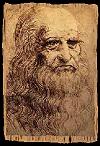|
Statue of Francesco Sforza The Last Supper.
The Battle of Anghiari. The Statue of Francesco Sforza. These three items have two things in common. The first is they were intended to be Leonardo's greatest achievements. The second is that all failed. Starting in 1483, a design was developed for a massive statue of Francesco Sforza, Ludovico's father. He would be displayed mounted on a horse and the entire piece would stand over 17 metres tall and weigh approximately eighty tons. That would have made it twice the size of any an other equestrian statue of the time. Leonardo spent much time thinking about the statue and, as was his way, he didn't do much obvious work on it until April, 1490 when he heard Ludovico was threatening to find another sculptor. At this point he decided to use one of the horses in Ludovico's bodyguard as his model. The Statue of Francesco Sforza would have been Leonardo's only major work of sculpture. He apparently did not hold this form of art in very high regard and wrote in his notebooks that working with stone was a, "wholly mechanical exercise." However, this statue was different. Not only would it be cast in bronze, but Leonardo had a craze for horses and once he started work he drew huge numbers of sketches on the subject. Leonardo's original intention was to show the horse as rearing on it's hind legs; this obviously would not work without some support for the front end, so a fallen soldier or a tree log was to be under the hooves of the horse to provide balance. Practicalities put an end to this design as it proved impossible to cast. The second version simply showed the horse as walking; this was a design that would become the model for many later equestrian statues by various artists. During his development of the design Leonardo did exhaustive work, studying horses, drawing one detailed anatomical study followed by another. He drew directly from nature, frequenting the stables to ensure accuracy of detail. It was noted that Leonardo exhibited no such interest in the intended rider; he was treated almost as an afterthought. From what can be ascertained through Leonardo's drawings, the rider was holding the baton of high command in his right hand, the reins in his left, and was bare-headed. By 1493 Ludovico was once again becoming impatient. He wrote to Leonardo and instructed that the statue must be ready by November for the marriage of his illegitimate daughter. Leonardo replied that he could deliver only the clay model and, somewhat surprisingly, he did so. This then went on display in the courtyard of the Palazzo Vecchio and was received warmly by the Milanese, becoming known as 'colosso'. At the unveiling it was described thus: "see, he has had a great colossus of bronze made in the courtyard to the memory of his father. I firmly believe that Greece and Rome never saw a bigger. Just look how beautiful that horse is! Leonardo Vinci did it all alone." It was the statue that made Leonardo famous throughout Italy which was somewhat ironic as he considered sculpting to be noisy and dirty work. Leonardo drew up plans for the building of four enormous furnaces required to cast the statue; he then designed a crate which would hold the clay model during transport to the foundry. The next step was to collect the enormous quantities of bronze needed for such an enormous piece. Almost as soon as this was done Milan came under threat of attack by the French and the bronze was taken to be used for the manufacture of cannons. Even the clay model was lost when the French used it for target practice. The little that remained was taken to the Court of Ferrara where it was claimed by neglect and decay. So, sadly the result of nearly 16 years of sporadic work was nothing. In modern time the decision was taken to make nothing into something. Read about the creation of Leonardo's Horse here. Trivulzio Monument Leonardo also had a second attempt at a horse and rider statue as a funeral monument for Gian Giacomo Trivulzio. The exact date for this project is unknown, and there remain few references to it, however Trivulzio founded a mortuary chapel for his family in 1511 and it is reasonable to assume it would have been close to this date. The statue was to consist of a "bronze horse and rider, a marble base with eight columns and eight sculptured figures, together with recumbent figure of the marshal accompanied by six harpies with candelabra." Whereas Leonardo did many detailed drawings for the Sforza statue, there are only a few small and obviously quick sketches which are for a statue of this type. Still they show the same initial ambition of the early plans for the Sforza statue and are similar in that Leonardo had early plans to show the horse as prancing over the form of a fallen enemy. Adoration of the Magi The first documented work in which horses appeared is the Adoration of the Magi. The cartoon for this work contains horses standing, walking, prancing and rearing, but they look far from realistic. Leonardo has drawn these animals with very wide foreheads which narrow down to their nostrils; the muzzles are very circular and wide. |
|

